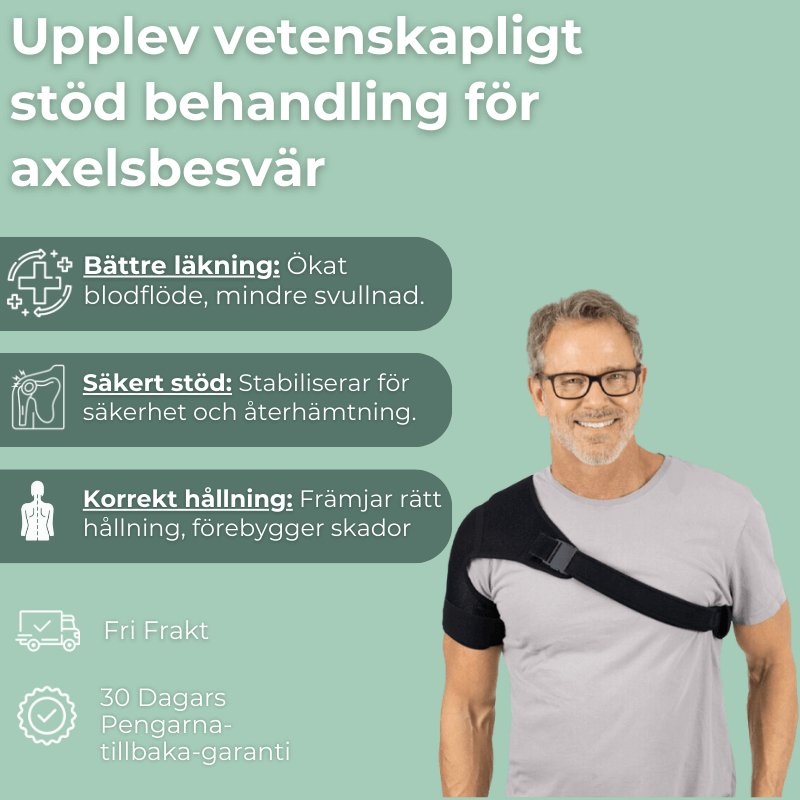Shoulder Bursitis: Symptoms, Causes & Treatment

Bursitis in the shoulder, also known as shoulder bursitis, is a painful condition that occurs when the bursa, a fluid-filled cushion that reduces friction between tissues, becomes inflamed. This condition can cause significant discomfort and limit shoulder mobility. In this article, we will go through the most common symptoms, causes, and treatment options for bursitis in the shoulder.
What is Bursitis in the Shoulder? Definition and Understanding of Bursa Inflammation
Bursa inflammation in the shoulder is an inflammation of the fluid-filled sac that reduces friction between the bones and tendons of the shoulder. The condition causes pain, swelling, and reduced mobility. Rest, anti-inflammatory medications, and physical therapy can assist in treatment.
Symptoms of Shoulder Bursitis: From Pain to Reduced Mobility
Shoulder bursitis can manifest in several ways, and the symptoms can vary in intensity. Common symptoms include:
- Pain in the shoulder: This is often the most prominent symptom. The pain can be sharp or dull and is often worsened by movement or pressure on the shoulder.
- Swelling and tenderness: The affected area may swell and feel tender to the touch.
- Limited mobility: You may experience difficulty moving your arm, especially when trying to lift it outward or overhead.
- Stiffness: The shoulder may feel stiff, particularly in the morning or after prolonged periods of inactivity.
- Warmth sensation: The inflamed area may feel warm to the touch.
- Pain that worsens at night: Many experience increased pain when lying on the affected shoulder.
Bursitis can also cause pain in the arm, especially when lifting it to shoulder height or higher. In some cases, the bursa may become so swollen that it is visible under the skin. Long-lasting issues can lead to reduced function in the shoulder joint and affect daily activities. This condition is sometimes confused with impingement as their symptoms can resemble each other.
Causes of Shoulder Bursitis: Risk Factors and Impact on Bursae
Several factors can contribute to developing bursitis in the shoulder:
- Overuse: Repetitive movements or prolonged strain on the shoulder can irritate the bursa.
- Injury or trauma: A direct blow to the shoulder or a fall can cause inflammation of the bursa.
- Infection: In rare cases, a bacterial infection may lead to bursitis.
- Underlying conditions: Certain conditions such as rheumatoid arthritis or gout may increase the risk of bursitis.
- Aging: The risk of bursitis increases with age as tissues become less elastic.
- Poor posture: Prolonged improper posture can increase strain on the shoulder's bursae.
Bursitis, also known as bursitis, is not unique to shoulders but can occur in other joints such as knees, hips, or elbows. Hip bursitis often occurs on the outside of the hip and causes similar symptoms. When structures around a bursa are repeatedly stressed—especially tendons located nearby—inflammation may develop and worsen over time.
Diagnosis and Treatment of Bursitis in the Shoulder
To effectively treat bursitis in the shoulder, it is important to obtain an accurate diagnosis and choose the right treatment method:
| Behandlingsmetod | Beskrivning | Fördelar med AxelKomforten™ och Termoreliever™ |
|---|---|---|
| Vila och avlastning | Minska belastningen på axeln | AxelKomforten™ ger stöd och avlastning |
| Kyl- och värmeterapi | Lindrar smärta och inflammation | Termoreliever™ erbjuder både kyl- och värmeterapi |
| Antiinflammatoriska läkemedel | Minskar inflammation och smärta | Kan minska behovet av medicin genom naturlig lindring |
| Fysioterapi | Övningar för att återfå rörlighet och styrka | AxelKomforten™ stödjer under övningar |

How AxelKomforten™ and Termoreliever™ Can Help: Support, Pain Relief, and Improved Mobility
AxelKomforten™ and Termoreliever™ offer several benefits for individuals suffering from shoulder bursitis:
- AxelKomforten™ provides support and relief to the affected shoulder, which can reduce strain on the inflamed bursa.
- Termoreliever™ offers both cold and heat therapy, which is essential for managing inflammation and pain. Cold therapy can be used in the acute phase to reduce swelling, while heat therapy can be used later to increase blood circulation and promote healing.
- The combination of these products can help accelerate recovery by providing continuous support and pain relief.
- The products can be customized to individual needs and used both during rest and light activity.
- Regular use may potentially reduce the risk of recurrence by supporting proper posture and reducing shoulder overload.
By supporting the shoulder in the correct position, AxelKomforten™ can help prevent structures from getting pinched, which is particularly important as bursitis and impingement often occur simultaneously. The goal is to achieve a pain-free shoulder with full mobility and function.
Conclusion
Bursitis in the shoulder can be a painful and limiting condition, but with the right diagnosis and treatment, most individuals can experience significant improvements. By combining traditional treatment methods with innovative aids like AxelKomforten™ and Termoreliever™, many can effectively manage their symptoms and regain normal shoulder function. It is important to listen to your body's signals and seek professional help if symptoms persist or worsen.
For many, bursitis is a recurring issue, making preventive measures just as important as acute treatment. By using the correct technique during physical activities, avoiding overexertion, and regularly strengthening the muscles around the shoulder, the risk of future inflammation can be significantly reduced.
Frequently Asked Questions (FAQ)
How long does shoulder bursitis usually last?
With the right treatment, many can experience improvement within a few weeks. However, some cases may take longer, up to several months, depending on the severity.
Can I exercise with bursitis in the shoulder?
Light exercise and specific workouts can often be part of the treatment, but it is important to avoid activities that worsen the pain. Consult with a physiotherapist for a tailored exercise program.
How do I use Termoreliever™ for bursitis in the shoulder?
Use cold therapy in the acute phase to reduce inflammation, typically for 15-20 minutes at a time, several times a day. Then switch to heat therapy to promote healing and increase mobility.
Can AxelKomforten™ prevent shoulder bursitis?
Yes, by providing support and improving posture, AxelKomforten™ can help reduce the risk of strain and inflammation in the shoulder's bursae.
When should I seek medical care for bursitis in the shoulder?
Seek medical attention if the pain is intense, if you have significant swelling or redness, if you have a fever, or if symptoms do not improve after a few days of self-care.
